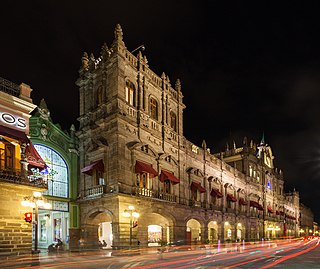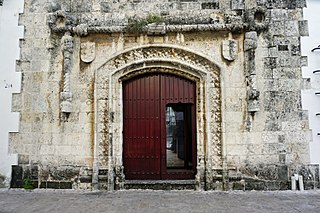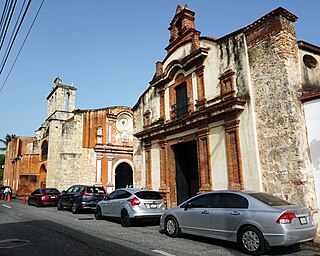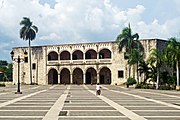
Santo Domingo, once known as Santo Domingo de Guzmán and Ciudad Trujillo, is the capital and largest city of the Dominican Republic and the largest metropolitan area in the Caribbean by population. As of 2022, the city and immediate surrounding area had a population of 1,484,789, while the total population is 2,995,211 when including Greater Santo Domingo. The city is coterminous with the boundaries of the Distrito Nacional, itself bordered on three sides by Santo Domingo Province.

The Isabelline style, also called the Isabelline Gothic, or Castilian late Gothic, was the dominant architectural style of the Crown of Castile during the reign of the Catholic Monarchs, Queen Isabella I of Castile and King Ferdinand II of Aragon in the late-15th century to early-16th century. The Frenchman Émile Bertaux named the style after Queen Isabella.
Pedro de Córdoba OP (c.1460–1525) was a Spanish missionary, author and inquisitor on the island of Hispaniola. He was first to denounce the Spanish system known as the Encomienda, which amounted to the practical enslavement of natives of the New World, for the abuses that it engendered.

Ciudad Colonial is the historic central neighborhood of the Dominican Republic's capital Santo Domingo. It is the oldest continuously inhabited European-established settlement in the Americas. The area has been declared a World Heritage Site by UNESCO. It is also known as Zona Colonial or more colloquially as "La Zona".
Agustín Dávila Padilla was a Mexican Dominican, a writer and Bishop of Santo Domingo.
Domingo Betanzos was a Spanish Dominican missionary to New Spain, who participated in the "Spiritual Conquest", evangelizing the indigenous.

The Ozama Fortress, also formerly known as the city wall's Homage tower. It is one of the surviving sections of the Walls of Santo domingo, which is recognized by UNESCO as being the oldest military construction of European origin in the Americas. It was built between 1502-1508 by the Spanish at the entrance to Santo Domingo's Ciudad Colonial, Dominican Republic, and overlooking the Ozama River. Named after this river, the castle, also referred to as "La Fortaleza" or "The Fortress". It was declared by UNESCO as a World Heritage Site, together with the other historical monuments of the Ciudad Colonial.

The Museo de las Casas Reales is one of the important cultural monuments built during the colonial era in Hispaniola, now the Dominican Republic. It is located in the Colonial district of Santo Domingo.

The Hospital San Nicolás de Bari is a preserved hospital ruin, and it was recognized by UNESCO for being the oldest hospital built in the Americas. Construction began in 1503 in Santo Domingo, Dominican Republic, at the behest of governor Nicolás de Ovando. This grand project was in keeping with the desire to emulate European princely courts, and looked to Renaissance Italy for inspiration. At the time of its completion, the wards could accommodate up to 70 patients, comparable to the most advanced churches of Rome. It is likely that the model for the Hospital de San Nicolás was the large Ospedale di Santo Spirito in Sassia in Rome. The complex forms part of the Colonial Zone of Santo Domingo World Heritage Site.

The Reales Atarazanas is a waterside building that housed the shipyards, warehouses, customs house and tax offices of the old port of Santo Domingo, Dominican Republic. It was the property of the Spanish Crown. Begun in 1509, the Atarazanas is the oldest building of its type still standing in America, and one of a handful remaining in the Spanish world, amongst which are the Atarazanas Reales de Barcelona, in Barcelona, the Atarazanas Reales de Sevilla, in Seville, the Atarazanas del Grao in Valencia and the Royal Dockyard in Havana.

Tourism in the Dominican Republic is an important sector of the country's economy. More than 6 million tourists visit the Dominican Republic, making it the most popular tourist destination in the Caribbean and putting it in the top 5 overall in the Americas. The industry accounts for 11.6% of the nation's GDP and is a particularly important source of revenue in coastal areas of the country. The nation's tropical climate, white sand beaches, diverse mountainous landscape and colonial history attracts visitors from around the world.

Campuzano-Polanco was a prominent family from the colony of Santo Domingo with origins in Santiago de los Caballeros. During the colonial era of the Hispaniola, their members and descendants went on to occupy high political, military and ecclesiastical positions, locally and outside the Island, as well as in the metropolis of Spain. Their merits extend since the beginning and until the end of the colony.

The historic centre of Puebla was declared a World Heritage Site by UNESCO in 1987.

The Casa del Cordón is a property located in the Colonial City of Santo Domingo, in the Dominican Republic. It is the oldest European stone house in the Americas and probably the first European two-story house. Its name is due to the chiseled sash-and-cord that it presents on its façade, which is associated with the Franciscan Order. It is located on Isabel la Católica street with the corner of Emiliano Tejera.

The Casa de los Cinco Medallones is a Plateresque style house which was built in 1540. It is located in Santo Domingo, Dominican Republic.

The Casa del Sacramento, also called the Archbishop's House, is a colonial building located in Santo Domingo, Dominican Republic. It was built in 1523 by conquistador Diego Caballero, by the time secretary of the Real Audiencia of Santo Domingo, the house has two towers in the facade. On a time during the colony and now it is the residence of the Archbishop of Santo Domingo.

The Church and Convent of los Dominicos of the Colonial City of Santo Domingo in the Dominican Republic, is the oldest Catholic building in continuous use in the Americas, and also, according to the UNESCO, it was the headquarters of the first university in the Americas, which was called the Universidad Santo Tomás de Aquino. Today it is part of the Colonial City complex, as a World Heritage Site.

The Church of Nuestra Señora de Las Mercedes is a colonial Gothic church located in Santo Domingo, Dominican Republic.

The Chapel of la Tercera Orden Dominica is a colonial church building located in Santo Domingo, Dominican Republic. It was first constructed around 1514 by the Third Order of Saint Dominic, originally part of the Church and Convent of los Dominicos that together were the headquarters of the colonial Universidad Santo Tomás de Aquino. It was rebuilt in 1729 in its current aspect. It is currently home to Casa de la Juventud.












































